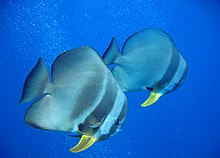Ephippidae
| Ephippidae Temporal range: | |
|---|---|

| |
| Platax teira | |
| Scientific classification | |
| Domain: | Eukaryota |
| Kingdom: | Animalia |
| Phylum: | Chordata |
| Class: | Actinopterygii |
| Order: | Acanthuriformes |
| Family: | Ephippidae Bleeker, 1859[1] |
| Genera | |
|
see text | |
Ephippidae is a family of percomorph fishes, the spadefishes, in the order Moroniformes. These fishes are found in the tropical and temperate oceans of the world, except for the central Pacific.
Taxonomy
Ephippidae was first proposed as a family in 1859 by the Dutch herpetologist and ichthyologist Pieter Bleeker.[1] The 5th edition of the Fishes of the World classifies this family in the order Moroniformes with the Moronidae and Drepaneidae.[2] Other authorities place this family alongside the Drepaneidae in the order Ephippiformes with the Moronidae classified as incertae sedis in the series Eupercaria.[3] Other authorities classify all three families in the Moroniformes sensu Fishes of the World in the Acanthuriformes.[4]
Genera
Ephippidae contains the following genera, 8 extant and 3 extinct († means extinct):[5][6][7]
- †Archaephippus Blot, 1969
- Chaetodipterus Lacépède, 1802
- †Eoplatax Blot, 1969
- Ephippus Cuvier, 1816
- †Laparon Casier, 1966
- Parapsettus Steindachner, 1875
- Platax Cuvier, 1816
- Proteracanthus Günther, 1859
- Rhinoprenes Munro, 1964
- Tripterodon Playfair, 1867
- Zabidius Whitley, 1930
The extinct genus Exellia is classified within the Ephippidae by some authorities, other authorities place it in the family Exellidae.[8]
Characteristics

Ephippidae spadefishes have deep, oval-shaped, laterally compressed bodies with a short head and small terminal mouth. There are bands of brush like teeth on the jaws but there are no teeth on the roof of the mouth. The preoperculum has a finely serrated margin. There is a single dorsal fin which has 9 spines and between 21 and 28 soft rays, with the spiny portion of the fin being low. The front part of the soft part of the dorsal fin and the anal fin are elongated. The anal fin has 3 spines and between 16 and 24 soft rays. The pectoral fins are short and the pelvic fins are long and are beneath the pectoral fins. The caudal fin is slightly concave, They have complete lateral line and the head, body and most of the fins are scaled. Young are frequently marked with black bars.[9] The largest species is the Atlantic spadefish (Chaetodipterus faber) which has a maximum published total length of 91 cm (36 in) while the smallest is the threadfin scat (Rhinoprenes pentanemus) which has a maximum published total length of 15 cm (5.9 in).[5]
Distribution
Ephippidae fishes are found throughout the warmer waters of the world but are absent from the central Pacific.[9] Ephippidae spadefishes (Chaetodipterus faber) are the only ephippid found in the western Atlantic Ocean.[10] While Ephippidae spadefishes are common in the western Atlantic from New England to southern Brazil, adult spadefishes are difficult to harvest commercially due to their size and preferred habitats of submerged spaces, despite consumer appeal for its nutrients and quality of flesh. [11]
Biology
Ephippidae spadefishes eat algae, benthic and planktonic invertebrates such as sponges, zoantharians, polychaete worms, gorgonians and tunicates.[9] The batfish Platax pinnatus may play the role of a critical functional group in the Great Barrier Reef by eating seaweed that other herbivorous fishes such as parrotfish and surgeonfish will not touch.[12] Overgrowth of seaweed among corals occurs as a result of overfishing of large fish species and inhibits the ability of coral to support life.[13]
References
- ^ a b Richard van der Laan; William N. Eschmeyer & Ronald Fricke (2014). "Family-group names of Recent fishes". Zootaxa. 3882 (2): 001–230. doi:10.11646/zootaxa.3882.1.1. PMID 25543675.
- ^ J. S. Nelson; T. C. Grande; M. V. H. Wilson (2016). Fishes of the World (5th ed.). Wiley. pp. 495–497. ISBN 978-1-118-34233-6. Archived from the original on 2019-04-08. Retrieved 2023-03-31.
- ^ Ricardo Betancur-R; Edward O. Wiley; Gloria Arratia; et al. (2017). "Phylogenetic classification of bony fishes". BMC Evolutionary Biology. 17 (162): 162. Bibcode:2017BMCEE..17..162B. doi:10.1186/s12862-017-0958-3. PMC 5501477. PMID 28683774.
- ^ Ron Fricke; William Eschmeyer; and Jon David Fong (2020). "GENERA/SPECIES BY FAMILY/SUBFAMILY IN Eschmeyer's Catalog of Fishes". Eschmeyer's Catalog of Fishes.
- ^ a b Froese, Rainer; Pauly, Daniel (eds.). "Family Ephippidae". FishBase. February 2023 version.
- ^ Eschmeyer, William N.; Fricke, Ron & van der Laan, Richard (eds.). "Genera in the family Ephippidae". Catalog of Fishes. California Academy of Sciences. Retrieved 31 March 2023.
- ^ "Family Ephippidae (ray-finned fish)". Paleobiology Database. Retrieved 6 April 2023.
- ^ Bannikov, Alexandre F.; Tyler, James C. (1995). "Phylogenetic Revision of the Fish Families Luvaridae and Kushlukiidae (Acanthuroidei), with a New Genus and Two New Species of Eocene Luvarids". Smithsonian Contributions to Paleobiology (81): 1–45. doi:10.5479/si.00810266.81.1.
- ^ a b c "Family: EPHIPPIDAE, Spadefishes". Shorefishes of the Greater Caribbean online information system. Smithsonian Tropical Research Institute. Retrieved 31 March 2023.
- ^ Trushenski, Jesse; Rombenso, Artur; Schwarz, Michael H.; Bowzer, John; Gause, Brian; Delbos, Brendan; Sampaio, Luis A. (January 2012). "Feeding Rate and Frequency Affect Growth of Juvenile Atlantic Spadefish". North American Journal of Aquaculture. 74 (1): 107–112. doi:10.1080/15222055.2012.655853. ISSN 1522-2055.
- ^ Trushenski, Jesse T.; Schwarz, Michael H.; Bowzer, John C.; Gause, Brian R.; Fenn, Teresa; Delbos, Brendan C. (July 2012). "Temperature Affects Growth and Tissue Fatty Acid Composition of Juvenile Atlantic Spadefish". North American Journal of Aquaculture. 74 (3) (published 2012-06-26): 338–346. doi:10.1080/15222055.2012.676011. ISSN 1522-2055.
- ^ Bellwood, David R.; Hughes, Terry P.; Hoey, Andrew S. (1 December 2006). "Sleeping Functional Group Drives Coral-Reef Recovery". Current Biology. 16 (24): 2434–2439. doi:10.1016/j.cub.2006.10.030. PMID 17174918.
- ^ Batfish may come to the Great Barrier Reef's rescue
External links
- "Ephippidae". Integrated Taxonomic Information System. Retrieved 2 July 2008.
